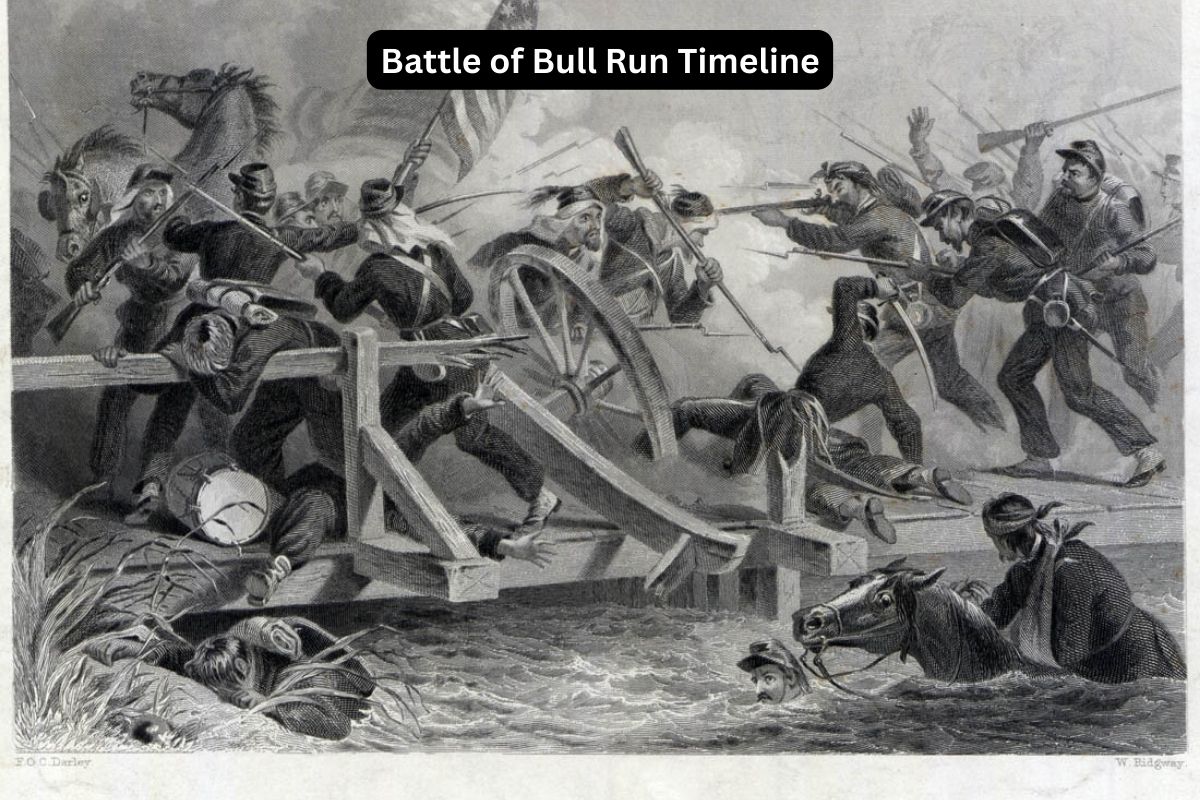The Battle of Bull Run, fought on July 21, 1861, near Manassas Junction, Virginia, marked a pivotal moment in the American Civil War.
As the first major land battle of the conflict, Bull Run shattered Northern illusions of a swift end to the war and underscored the challenges and realities of the conflict.
This article delves into the timeline and key events surrounding the Battle of Bull Run, highlighting its significance and the repercussions it had on the course of the Civil War.
From the initial Union advance under General Irvin McDowell to the chaotic retreat and subsequent reorganization of Union forces under Major General George B. McClellan, we explore the dramatic events that unfolded on the battlefield and the profound impact they had on both the Union and Confederate war efforts.
| Date | Event |
|---|---|
| July 16, 1861 | Union General Irvin McDowell’s Army of Northeastern Virginia begins march from Washington, D.C. |
| July 18, 1861 | Confederate General P.G.T. Beauregard receives intelligence of McDowell’s advance. |
| July 21, 1861 | – Battle of Bull Run: First major land battle of the Civil War. |
| – Early Morning: Union forces engage Confederate forces near Bull Run Creek. | |
| – Morning: Intense combat at Matthews Hill. | |
| – Midday: Confederate reinforcements stabilize the line. | |
| – Afternoon: Confederate counterattack drives Union forces back in chaotic retreat. | |
| July 22, 1861 | Both armies dig in and fortify their positions, marking the end of major combat operations. |
| July 25, 1861 | Confederate President Jefferson Davis congratulates troops on their victory at Bull Run. |
| August 1861 | Union Army, under Major General George B. McClellan, begins reorganization and training. |
Timeline of the Battle of Bull Run
July 16, 1861: Union General Irvin McDowell’s Army of Northeastern Virginia begins march from Washington, D.C
Union General Irvin McDowell’s Army of Northeastern Virginia, consisting of around 35,000 men, begins its march from Washington, D.C., towards the Confederate forces stationed near Manassas Junction, Virginia.
This movement marks the beginning of what would later be known as the First Battle of Bull Run.

July 18, 1861: Confederate General P.G.T. Beauregard receives intelligence of McDowell’s advance
Confederate General P.G.T. Beauregard, commanding the Confederate forces at Manassas Junction, receives intelligence of McDowell’s advance.
Beauregard quickly begins preparations to meet the Union army, rallying his troops and fortifying defensive positions around Bull Run.
July 21, 1861: Battle of Bull Run: First major land battle of the Civil War.
The Battle of Bull Run, also known as the First Battle of Manassas, takes place. It is the first major land battle of the American Civil War.
- Early Morning: Union forces engage Confederate troops near Bull Run Creek, initiating the battle. The initial clashes occur as both sides test each other’s strength and positions.
- Morning: Intense fighting erupts at Matthews Hill as Union forces attempt to push through the Confederate defenses. The Confederate line holds despite heavy pressure from the Union army.
- Midday: Confederate General Thomas “Stonewall” Jackson’s timely arrival with reinforcements helps stabilize the Confederate line, preventing a Union breakthrough.
- Afternoon: Confederate forces, buoyed by the arrival of reinforcements and led by Jackson’s counterattack, launch a decisive assault against the Union army. The Union forces, facing overwhelming Confederate pressure, begin a disorganized retreat towards Washington, D.C. The chaotic withdrawal leads to panic among civilians who had come out to watch the battle, resulting in traffic jams and confusion on the roads back to the capital.
July 22, 1861: Both armies dig in and fortify their positions, marking the end of major combat operations
Following the Union defeat at Bull Run, both Union and Confederate forces dig in and fortify their positions along Bull Run and other strategic locations.
The Confederate troops, under General Beauregard, consolidate their victory and prepare to defend their newly gained territory, while the Union army, now under the command of Major General George B. McClellan, begins to regroup and reorganize.
In Washington, D.C., the Union government faces the sobering reality of the defeat at Bull Run. There is a sense of urgency to reinforce the Union army and bolster its capabilities for future engagements.

July 25, 1861: Confederate President Jefferson Davis congratulates troops on their victory at Bull Run
Confederate President Jefferson Davis arrives at the battlefield at Manassas Junction to congratulate General Beauregard and his troops on their victory at Bull Run.
Davis’s presence serves to boost morale among the Confederate forces and underscores the significance of their achievement in repelling the Union army’s advance.
Davis also uses the opportunity to assess the strategic situation and confer with Beauregard and other Confederate commanders on future plans and operations in the Eastern Theater of the war.
August 1861: Union Army, under Major General George B. McClellan, begins reorganization and training
With the immediate aftermath of the Battle of Bull Run settling, both the Union and Confederate armies focus on consolidating their positions and preparing for further military actions.
The Union Army, now under the leadership of Major General George B. McClellan, embarks on a period of intense reorganization and training. McClellan, known for his meticulous planning and attention to detail, works to improve the discipline, morale, and effectiveness of the Union troops. Additionally, efforts are made to reinforce the Union army’s logistical capabilities and supply lines to ensure future campaigns are better supported.
Meanwhile, the Confederate forces, buoyed by their victory at Bull Run, continue to strengthen their defenses and expand their military infrastructure in Northern Virginia. Confederate commanders assess their strategic options and prepare for potential Union offensives, recognizing the need to maintain their momentum and capitalize on their recent success.
